Abstract
Contact dermatitis comprises two main groups: irritant (ICD) and allergic (ACD) contact dermatitis. It presents as acute, subacute, or chronic eczema. Although it is possible to differentiate ICD from ACD on clinical ground, both diseases can have very similar clinical, histological, and molecular presentations.
The mechanisms at the origin of the eczema are different in the two types of dermatitis, at least as far as the initiation stages of the skin inflammation are concerned. ICD is a nonspecific inflammatory dermatosis, mainly due to the toxicity of chemicals on the skin cells which triggers inflammation by activation of the skin innate immune system.
Access this chapter
Tax calculation will be finalised at checkout
Purchases are for personal use only
References
Nosbaum A, Vocanson M, Rozieres A, Hennino A, Nicolas JF (2009) Allergic and irritant contact dermatitis. Pathophysiology and immunological diagnosis. Eur J Dermatol 19:1–8
Vocanson M, Hennino A, Rozières A, Poyet G, Nicolas JF (2009) Effector and regulatory mechanisms in allergic contact dermatitis. Allergy 64:1699–1714
Fyhrquist-Vanni N, Alenius H, Lauerma A (2007) Contact dermatitis. Dermatol Clin 25:613–623
Bonneville M, Rozières A, Chabeau G, Saint-Mezard P, Nicolas J-F (2004) Physiopathologie de la dermatite irritante de contact. In: Progrès en dermato-allergologie. John Libbey Eurotext, Paris, pp 177–187
Lepoittevin J-P, Leblond I (1997) Hapten determinants for T cells. Eur J Dermatol 7:151–154
Basketter DA, Kan-King-Yu D, Dierkes P, Jowsey IR (2007) Does irritation potency contribute to the skin sensitization potency of contact allergens? Cutan Ocul Toxicol 26:279–286
Martin SF, Esser PR, Weber FC, Jakob T, Freudenberg MA, Schmidt M, Goebeler M (2011) Mechanisms of chemical-induced innate immunity in allergic contact dermatitis. Allergy 66:1152–1163
de Jongh CM, Lutter R, Verberk MM, Kezic S (2007) Differential cytokine expression in skin after single and repeated irritation by sodium lauryl sulphate. Exp Dermatol 16:1032–1040
Norman MU, Hwang J, Hulliger S, Bonder CS, Yamanouchi J, Santamaria P, Kubes P (2008) Mast cells regulate the magnitude and the cytokine microenvironment of the contact hypersensitivity response. Am J Pathol 172:1638–1649
Vocanson M, Hennino A, Poyet G, Nicolas JF (2007) Experimental models of contact dermatitis. Rev Fr Allergol Immunol Clin 47:314–317
Vocanson M, Hennino A, Chavagnac C, Saint-Mezard P, Dubois B, Kaiserlian D, Nicolas JF (2005) Contribution of CD4+ and CD8+ T cells in contact hypersensitivity and allergic contact dermatitis. Expert Rev Clin Immunol 1:75–86
Cavani A (2008) T regulatory cells in contact hypersensitivity. Curr Opin Allergy Clin Immunol 8(4):294–298
Basketter D, Darlenski R, Fluhr JW (2008) Skin irritation and sensitization: mechanisms and new approaches for risk assessment. Skin Pharmacol Physiol 21:191–202
Bonneville M, Chavagnac C, Vocanson M, Rozieres A, Benetiere J, Pernet I, Denis A, Nicolas JF, Hennino A (2007) Skin contact irritation conditions the development and severity of allergic contact dermatitis. J Invest Dermatol 127:1430–1437
Vocanson M, Hennino A, Rozieres A, Poyet G, Gaillard V, Achachi A, Benetiere J, Kaiserlian D, Dubois B, Nicolas JF (2010) ICOS is a marker for highly suppressive antigen-specific T cells sharing features of Th17/Th1 and regulatory T cells. J Allergy Clin Immunol 126:280–289
Author information
Authors and Affiliations
Rights and permissions
Copyright information
© 2012 Springer-Verlag Berlin Heidelberg
About this chapter
Cite this chapter
Nosbaum, A., Nicolas, JF., Lachapelle, JM. (2012). Pathophysiology of Allergic and Irritant Contact Dermatitis. In: Patch Testing and Prick Testing. Springer, Berlin, Heidelberg. https://doi.org/10.1007/978-3-642-25492-5_1
Download citation
DOI: https://doi.org/10.1007/978-3-642-25492-5_1
Published:
Publisher Name: Springer, Berlin, Heidelberg
Print ISBN: 978-3-642-25491-8
Online ISBN: 978-3-642-25492-5
eBook Packages: MedicineMedicine (R0)

